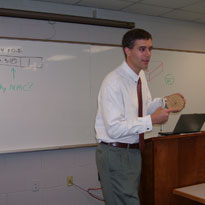Reliability Engineering
- Course:Reliability Engineering
- Course ID:RELENG Duration:3 days Where: Your Office (7+ Persons)
- Download Course Description (PDF)
Available as a private, customized course for your group at your offices or ours and in some cases as a WebLive(TM) class.
Course Outline
Course Day 1
Introductions
- Reliability history and objectives.
- Basic principles.
- The nature of engineering design versus reliability analysis.
- Group activity.
Reliability Mathematics
- Reliability distributions, including exponential and binomial distributions.
- Probability and the Bayes Theorem.
- Reliability equations.
- Reliability block diagrams.
- Excel applications.
- Group activity.
Failure Rate, MTBF, and Other Reliability Metrics
- Failure rate sources.
- MIL-HDBK-217F.
- NPRD-2011.
- Supplier data.
- MTBF, MTBUR, URR, and other calculations.
- Excel applications.
- Group activity.
Hardware, Firmware, and Software Reliability
- Hardware, firmware, and software definitions.
- The nature of firmware and software “failures.”
- Software test approaches and objectives.
- Improving software reliability.
- Group activity.
Reliability Testing and Growth
- MIL-STD-785.
- Reliability demonstration testing.
- Test, analysis, and fix (TAAF) approaches.
- Reliability growth models.
- The Duane growth model.
- Excel applications.
- Group activity.
Course Day 2
Failure Modes and Effects Analysis
- FMEA history, applications, and objectives
- MIL-STD-1629, SAE J1739, and other FMEA standards.
- Design and Process FMEA.
- Risk Priority Number calculations.
- Corrective and preventive actions.
- Using Excel to streamline the FMEA process.
- Failure mode effects summaries (FMES).
- Excel applications.
- Group activity.
Design of Experiments
- Hypothesis testing.
- z-tests, t-tests, f-tests, and others.
- ANOVA considerations.
- Taguchi and fractional factorial experimental approaches.
- Excel applications.
- Group activity.
Process Capability
- Process capability definitions.
- The normal curve.
- Design and process tolerances versus process capability.
- Cp and Cpk.
- Sampling plans.
- Operating characteristic curves.
- Statistical process control.
- Using Excel for Cp and Cpk calculations.
- Predicting rejection probabilities based on process capability.
- Group activity.
Course Day 3
Root Cause Failure Analysis
- The four-step problem solving process.
- Ishikawa diagrams, mind mapping, 5-Whys, and flow charting.
- Fault tree analysis.
- Managing the failure analysis.
- FMA&A matrices.
- Corrective and preventive action.
- Group activity.
Reliability of Single-Shot Devices
- Munitions, ammunition, airbags, and other energetic material devices.
- Bruceton testing.
- The Butterfield model.
- Space ordnance considerations.
- Excel applications.
- Group activity.
Product and Process Reliability
- Applying reliability engineering concepts to process analysis.
- Typical process reliability challenges.
- Poka-Yoke techniques and applications for preventing design and process mistakes.
- Excel applications.
- Group activity.
Warranty Considerations
- The nature of product warranties.
- Defining warranty requirements.
- Predicting long term reliability from a warranty perspective.
- Identifying and correcting reliability degradation drivers.
- Warranty financial considerations.
- Developing a warranty testing approach.
- Warranty remedy considerations.
- Excel applications.
- Group activity.
System Safety Considerations
- System safety history.
- MIL-STD-882.
- Preliminary hazard analyses.
- Operating hazard analyses.
- Subsystem hazard analysis.
- Fault tree analysis.
- Excel applications.
- Group activity.
Course Review and Critique
- Course review.
- Developing a go-forward plan.
Course in a Nutshell
This course brings together important concepts that allow engineering and operations organizations to understand and implement reliability engineering concepts. These techniques include reliability prediction techniques, Failure Modes and Effects Analysis, root cause failure analysis, fault tree analysis, PokaYoke concepts, design of experiments, process capability, system safety considerations, and other key reliability engineering technologies.
The focus is on applying these concepts to optimize product and process reliability, with an emphasis on implementation. The course utilizes real-life case studies, numerous group activities, and detailed Excel templates for immediate application of these techniques to your design and product improvement challenges. By the end of the course, you will have a thorough understanding of reliability engineering tools, technologies, terminology, and capabilities, and your staff will be able to implement these important tools in your organization.
Learn How To
- Work together in an effective team environment to implement reliability engineering concepts.
- Use the technologies presented in this course to identify key product and process reliability weaknesses and improvement opportunities.
- Proactively design test and inspection approaches that are consistent with product and process reliability.
Aimed At
This course is aimed at design, engineering, quality assurance, and manufacturing personnel involved in product and process design and improvement.
Prerequisites
While there are no formal prerequisites, the course assumes a process, industrial, manufacturing, or engineering background.

